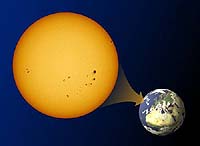| . |  |
. |
 Holes In Sun's Corona Puts A Hole In Climate Science
Holes In Sun's Corona Puts A Hole In Climate ScienceBrooklyn - March 2, 2000 - An unusual interdisciplinary study by astronomers and climatologists has found a striking correlation between holes in the outermost layer of the sun--or the corona--and the globally averaged temperature of the Earth, suggesting that the Earth's atmospheric temperature may be strongly linked to solar magnetism changes over months or years. In a paper that appears in the February 28 issue of the journal New Astronomy, climatologist Eric Posmentier of Long Island University's Brooklyn Campus, solar physicists Willie Soon and Sallie Baliunas of the Harvard-Smithsonian Center for Astrophysics and physicist Pius Okeke of the University of Nigeria chart temperature anomalies seen in the Earth's lower troposphere (i.e., the region of atmosphere in which we live) using Microwave Sounding Unit (MSU) radiometers aboard weather satellites. The scientists compared the Earth's temperature with the size of coronal holes reported on the Sun during a two-decade period, starting in January 1979 and ending April 1998. Results show a clear drop in terrestrial atmospheric temperature after the Sun's magnetic field activity is most intense. At this point, there is a dropping off of magnetic activity and an enlargement of the coronal holes. "This is the first time anyone has combined these modern, reliable data sets to link solar activity and climate, and to cite several alternative mechanisms that might explain this link," Posmentier explained. Coronal holes are, literally, gaps in the Sun's outer atmosphere through which the stream of hot, supersonic particles known as the solar wind pours out into space to engulf the entire planetary system. At Earth, this hot bath of charged particles produces the aurorae (i.e., the aurora borealis), interferes with electrical and radio transmissions, and may threaten passengers aboard high-flying airliners or astronauts aboard unshielded spacecraft. The solar wind has also been long suspected as a possible indirect contributor to terrestrial climate change. Posmentier and colleagues think that the connection between the solar wind and climate may be more direct, suggesting that the charged particles hitting the Earth's atmosphere may affect the properties of terrestrial water clouds, particularly the percentage of those clouds covering the Earth. In turn, significant changes in the cloud cover influence the temperature of the lower troposphere, with temperatures falling with increased cloud cover. Another possibility is that the charged particles change ozone chemistry in the upper atmosphere, in turn affecting the dynamics of the climate. The scientists note, however, that the charged particles hitting the Earth could come from either the Sun, or from galactic cosmic rays that are modulated by the solar wind. Or, from a combination of both sources. Regardless, the percentage of the Sun's surface covered by coronal holes seems to be a fairly accurate indicator of temperature in the Earth's troposphere over months or years. The correlation comes with some caveats. As Posmentier and colleagues note, other major climate factors are also at work concurrently, thus complicating attempts to correlate Sun-Earth phenomena. Most notable in the past two decades have been the warming effects of the 1997-98 El Nino and the general cooling that followed the eruption of Mount Pinatubo in 1991. According to Posmentier, their results do not rule out the possible climate influence of man-made fossil fuels, which have caused the atmosphere's CO2 levels to rise. "During some parts of the last century, as the amount of CO2 increased, the temperature increased," he explained. "I don't dispute that, and I'm not saying that CO2 can't have significant effects in the future. "What I am saying is the data do not unambiguously support the contention that CO2 increases are the dominant cause of climate variability," he added. "There are other reasons for climate variations that are significant. In fact, we've found that the strongest correlation is the one between the area of the Sun's surface covered with holes and the globally averaged temperature of the Earth." Support for this research came from the Mount Wilson Institute and the Electric Power Research Institute, with additional funding from the Massachusetts Space Grant Consortium, the Smithsonian Institution, the Richard C. Lounsbery Foundation, and NASA.
Read On For A Climatic Week At TerraDaily
Related Sites This Article
|
| |||||||||
| The content herein, unless otherwise known to be public domain, are Copyright 1995-2016 - Space Media Network. All websites are published in Australia and are solely subject to Australian law and governed by Fair Use principals for news reporting and research purposes. AFP, UPI and IANS news wire stories are copyright Agence France-Presse, United Press International and Indo-Asia News Service. ESA news reports are copyright European Space Agency. All NASA sourced material is public domain. Additional copyrights may apply in whole or part to other bona fide parties. Advertising does not imply endorsement, agreement or approval of any opinions, statements or information provided by Space Media Network on any Web page published or hosted by Space Media Network. Privacy Statement All images and articles appearing on Space Media Network have been edited or digitally altered in some way. Any requests to remove copyright material will be acted upon in a timely and appropriate manner. Any attempt to extort money from Space Media Network will be ignored and reported to Australian Law Enforcement Agencies as a potential case of financial fraud involving the use of a telephonic carriage device or postal service. |